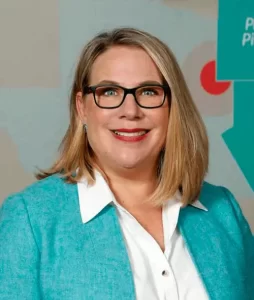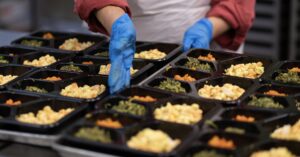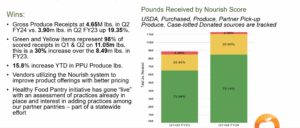Two years of knocking on doors and building relationships with health care clinics helped Tarrant Area Food Bank win a large grant from CVS Health Foundation to carry out a five-part Food is Medicine pilot.
The multi-year grant, funded at $750,000 a year, will feature medically tailored meals prepared by a chef with a master’s degree in nutrition and overseen by a registered dietitian. Bolstering the meals will be regular deliveries of produce prescription boxes and shelf stable ingredients, as well as nutrition education classes and direct referrals to government assistance.
Through the multi-pronged program, Tarrant Area Food Bank hopes to demonstrate the cost-effectiveness of providing healthy food first, rather than medical interventions later, to health-compromised individuals. It also hopes the five-part initiative can be a model for others to follow. “We’re excited about bringing this concept out not just for the neighbors we serve, but for the nation,” said Julie Butner, President and CEO.

The seeds for the program were planted a few years ago. In 2020, the food bank did not have a single registered dietitian on staff; now it has five. Two years ago, it did not have any relationships with health care providers. Now it has 23, and that number soon will rise to 45.
As a food bank CEO with a master’s degree in nutrition science, Butner gets credit for shifting the organization’s focus toward healthy food. “One of the reasons why I took the job at the food bank was this idea that if you feed people crappy food, they are just going to continue to be a burden on the healthcare system,” Butner said.
The food bank’s current relationships with health care providers began as training sessions on how to do food insecurity screenings. As of January 2024, such screenings are now required (see our article about that here), but many providers were not familiar with the screenings, or knew what to do if someone screened positive. “I was just doing road shows,” said Aime Hebdige, Chief Programs Officer. “Let me speak to your nurses. Let me speak to your clinicians.”
The training sessions led to warm referrals to the food bank’s SNAP outreach team, and eventually to a range of other types of partnerships, including placing food pharmacies inside emergency rooms, sending the food bank’s mobile grocery store out to various clinics, and providing healthy home deliveries to patients.
With the CVS grant, Tarrant Area Food Bank is working with a federally qualified health center and a local public hospital to target specific patient populations that would benefit from better nutrition. The public hospital, for example, is targeting maternal patients with diabetes and/or high blood pressure that live in a certain zip code. Eventually, the pilot is expected to expand to include another three health centers.
With the grant, Tarrant Area Food Bank will provide five family-style medically tailored meals per week; ten pounds of fresh produce per week; home delivery of 25 pounds of shelf-stable healthy groceries with recipes twice a month; nutrition education classes on diabetes and heart disease prevention, and direct referrals to SNAP, WIC and other government assistance.

The food bank will also hold the nutrition classes and encourage patients to attend by having their ready-to-eat meals and produce prescriptions ready for them to pick up at class. The health centers, meanwhile, will identify the highest need patients, and also measure health outcomes at 90 days and six months.
‘We wanted to really attack this problem and go in with a holistic approach, and not just say, ‘Take this nutrition class, or try to get food at your local food pantry.’” Hebdige said. “We’re going in with these five layers.”
The program will start small, serving only 25 patients from each clinic initially. “That’s a number I’m not so proud of,” Hebdige noted, “but it will become larger as we add more clinics.” She added that the goal is to attract other funders interested in improving patient health, “especially insurance carriers that have deep pockets, to prove out this concept and continue growing it.”
CVS Health Foundation, which has a longtime partnership with Feeding America, is providing similar grants to two other Feeding America food banks: Central California Food Bank and Feeding Tampa Bay. Feeding America is also working with Elevance Health Foundation, which in 2022 announced an investment of $14.1 million in Food is Medicine programs at more than 20 Feeding America food banks.
Looking forward, Tarrant Area Food Bank is planning to add a new career training/certification program focused on medically tailored meals. Such culinary medical courses are in very short supply, despite growing demand for such meals.
The food bank will also work with Feeding Texas, the state association of food banks, to help it collect health-outcomes data to demonstrate the value of nutrition interventions in community health. Such data could help persuade private insurers to provide reimbursements for nutrition support as a standard part of their coverage.
In the meantime, Tarrant Area Food Bank has created a five-part solution that it can present to health care providers as a funding opportunity based on the funding they have available. “It would be really easy for our food bank to say, ‘Here’s a list of pantries,’” Hebdige said. “But that’s not going to solve the issues that they have.” – Chris Costanzo
Like what you’re reading?
Support Food Bank News
This article was made possible by the readers who support Food Bank News, a national, editorially independent, nonprofit media organization. Food Bank News is not funded by any government agencies, nor is it part of a larger association or corporation. Your support helps ensure our continued solutions-oriented coverage of best practices in hunger relief. Thank you!
Connect with Us:










